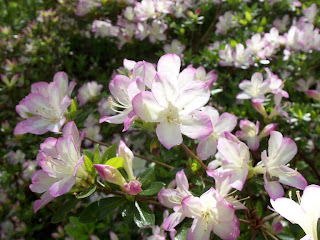 |
| design wall with improvisational blocks using green with white next to scrappy multi-colored blocks |
The colors I brought home were gray, brown and orange tangerine and marigold mostly and that is where I went with my improvisational block building once I realized it was making me feel energized to work with this mix more than others that evolved from the scrap heap. Then I began wondering how big my project would grow and how to lay it out once I had a number of blocks assembled.
Edge to edge or stacked on a gray background field were the two choices I considered.
 |
| layout with a gray field background |
I have been enjoying the play and the collection added one next to the other not worrying too much about size or relationships to the connecting blocks. This was meant to be very free and fun. To assemble them I need to be more thoughtful how the sizes line up and the edge designs and colors will come together. Also I am giving some thought to the balance of the entire collection of blocks. As I have worked on this I have had a few tiny scraps and I made two almost six inch square blocks to consider scale but over all the blocks have been getting bigger and the pieces wider and longer.
 |
| Mini block 6x7" |
 |
| Miniature block 6x6" |
The big blocks are adding in some of the new fabrics including a gray paisley, a brown printed black burlap design and the speckled gray "concrete" backing and a neutral tea stained muslin.
Do you have a preference or comment on how the final quilt or quilts might look best? I am looking forward to this week's DC Modern Quilters Guild meeting in Arlington where we are going to have another scrap swap this time with lots of quilter's bringing in scraps. We also have an orphan block quilt project that is seeking donations for a charity quilt and our quilter's name tag reveal. I also expect we will be talking about our plans to join the international organization of guilds called Modern Quilt Guild. I read the various definitions of "modern quilting" that the guild has used and began thinking that I need to look more at Modern art. I am a traditional kind of guy and look to Albrecht Dürer the 15th century German artist more than more recent works of art because I can relate to them better. Skill drawing and painting I can aspire to more than the mental feats of Modern art's conceptual creations. I understand these modern movements pretty well and admire and delight in the fun that they hold when they tantalize the mind and the spirit but sometimes I get board looking at them. So to quilt modern does one need to embrace the modern aesthetic? How does it relate to the history and the traditions of quilting? The ladies of Gee's Bend offer a way forward that uses both the fabric at hand and the chance of discovery by following your own voices when piecing a patch work. They were isolated from the museums and galleries that brought us minimalist and conceptual art yet they are heralded as makers of throughly "modern art quilts". I think the ideas of color and field and minimal are interesting but I like the complex layers of patterns and design that comes in a baroque like composition. Therefore I hope this orange project will be a beginning of a new kind of vision modern and traditional at once speaking to my roots and my education and our modern times.



















































